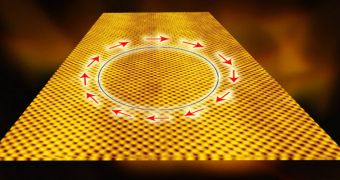A group of investigators in the United States announced the development of an advanced material, whose electrons do not couple with, or get scattered by, the quantized vibrational energy of crystalline materials, called phonons.
Though they are energy, phonons are treated in mathematics as particles. This makes it easier for scientists to understand the interactions developing between these particles and electrons.
What the experts behind this new study did was create a special topological insulator, whose electrons cannot be influenced by phonons without breaking the rules of quantum mechanics. A topological insulator (TI) is a material whose surface conducts electricity, but whose interior does not.
Details of the new investigation appear in a paper entitled “Measurement of an exceptionally weak electron-phonon coupling on the surface of the topological insulator Bi2Se3 using angle-resolved photoemission spectroscopy,” published in the latest online issue of Physical Review Letters.
The work is authored by Z.-H. Pan, A. V. Fedorov, D. Gardner, Y. S. Lee, S. Chu, and T. Valla, who are all based at the US Department of Energy's (DOE) Lawrence Berkeley National Laboratory (Berkeley Lab). Researchers here were the first to propose the existence of strong, 3D TI.
They were also the first to actually synthesize the materials. What is important to know about a TI's surface is that electrons at this location are locked together, and can only change at the same time.
In addition, these surface electrons cannot be scattered by common external factors, including perturbations in the material or other defects (they remain topologically protected). The only way for scattering to occur is by breaking the rules of quantum mechanics.
“One way that electrons lose mobility is by scattering on phonons. Our recent work on a particularly promising topological insulator shows that its surface electrons hardly couple with phonons at all. So there’s no impediment to developing this TI for spintronics and other applications,” Alexis Fedorov says.
The expert holds an appointment as a staff scientist at the Berkeley Lab Advanced Light Source (ALS) Beamline 12.0.1 facility, where most of the work was conducted. Fedorov explains that the advanced TI the team investigated is called bismuth selenide (Bi2Se3).
Among its properties is the fact that its surface electrons flow at room temperature, making it an ideal candidate for use in spintronic devices and quantum computers. “Although there’s still a long way to go, the experimental confirmation that electron-phonon coupling is very small underlines Bi2Se3’s practical potential.” Fedorov concludes.

 14 DAY TRIAL //
14 DAY TRIAL //